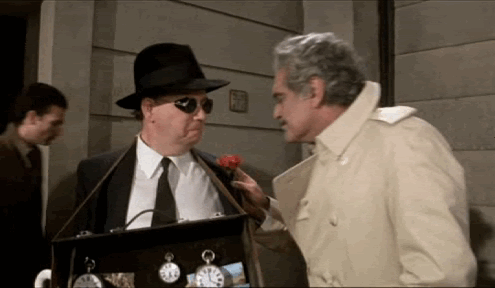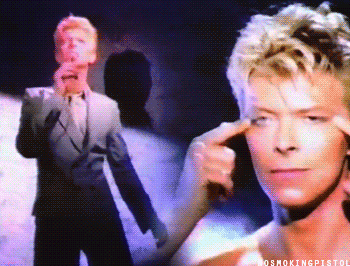Legendary Secret Weapons: Five Classic Songs With Notable Unsung Cameos
Secret weapons can come in many different forms.
It could be a splash you weren’t expecting when you stop to smell the roses, like this .GIF above from the hilarious 1984 spy-movie spoof Top Secret.
It could be quarterback Randall Cunningham surprising the Giants by booting a 91-yard punt on Monday Night Football.
It could be Keith Byars, taking a halfback pitch from Randall, running a sweep and then uncorking a TD pass just before he crossed the line of scrimmage.
It might even be Paul “Mr. Wonderful” Orndorf revealing himself to be the man masquerading as Kamala's manager behind his beekeeper mask, just after interfering with Hulk Hogan in a WWF Championship title match at the Philadelphia Spectrum during my 10th Birthday party.
In this episode of The Five Spot, the secret weapons come in musical form.
Here are five legends who on the following songs became “legendary secret weapons” and by doing so, helped to ensure that a major musical moment was recorded.
In some cases, people may still not even know they were on the record.
Listen/Read/Enjoy this one about some of our favorite subterranean superstars, who showed up to destroy:
Stevie Ray Vaughan, lead guitar on “Let’s Dance” by David Bowie
Despite Stevie Ray Vaughan & Double Trouble making a name for themselves on the Texas club circuit, Let’s Dance was Stevie Ray’s first officially released studio recording. Following a fortuitous meeting with Bowie after Double Trouble’s controversially loud set at the 1982 Montreaux Jazz Festival in Switzerland, Bowie enlisted him to play on his upcoming Nile Rodgers-produced album. He ended up doing so on six of the album’s eight tracks. The rest is musical history as well as a fun fact to toss out to the uninitiated when you hear this song playing in a bar.
Bowie asked SRV to join him on his Serious Moonlight tour after this became his biggest-selling album ever. Stevie declined either due to reports of Bowie offering him “scale” or because he was preoccupied with promoting Double Trouble’s debut album Texas Flood, which was released a few months after Bowie’s triumph. David Bowie always found great musicians, from Mick Ronson or Adrian Belew in the seventies up thru Donny McCaslin this year. However, nothing illustrates the scope of his keen eye for talent more than David Bowie albums being the home of both Stevie Ray Vaughan and Luther Vandross’ (Young Americans) first official studio recordings.
Prince, synths/keys and co-writer on “Stand Back” by Stevie Nicks
The late (still hurts to say), great Prince Rogers Nelson was perhaps the King of Musical Secret Weapons. He wrote and recorded essentially every instrument on his first five records, then under the alias Jamie Starr did the same for The Time’s first two albums aside from Morris’ lead vocal and Sheila E’s first two. In between there were hits and assists on works by The Bangles, Sheena Easton, Vanity 6, Common, Janelle Monae, Sinead O’Connor, Chaka Khan, The Family and more.
One of the more fruitful in terms of charts and legendary status was this 1983 Top 5 Pop Hit with the great Stevie Nicks. Nicks, during one of Fleetwood Mac’s famous hiatuses, says she was driving from her home in Malibu up to Santa Barbara on her wedding day and heard “Little Red Corvette” on the radio. Moved by the lush synth sounds on that record, she began singing the song that would form the basis for “Stand Back” over Prince’s melody. She pulled over to get a mini-tape-recorder and recorded the “demo” in their honeymoon hotel room that evening. When Stevie called Prince to tell him the story, he showed up to the studio the night that she was recording the song for her album, played the synths and helped mix it himself before disappearing from the studio shortly thereafter like it was all a dream. Yet not before leaving Stevie with a dream she’d like to sell, across several compilations and countless concert stages, for three decades and counting.
John Stephens (later John Legend), piano on Lauryn Hill’s “Everything Is Everything”
Years before achieving international fame under the Legend moniker on Kanye West’s G.O.O.D. Music label, John Stephens attended the University of Pennsylvania on an academic scholarship, after graduating high school at 15. While singing with a choir in North East Philadelphia as a UPENN student in his junior year, the would-be Legend met a friend of Lauryn Hill’s from New Jersey named Tara Michelle. Tara introduced 17-year-old John to the famous Fugee at the studio where she was working on her first (and somehow, still only) solo LP, The Miseducation of Lauryn Hill, in the Spring of 1997.
John laid down the crucial keys on the piano that along with the string sample form the sonic foundation of this classic cut. The reward for his efforts? The honor of meeting L-Boogie when she was the biggest thing in music, bragging rights on campus as Miseducation poured out of every dormitory in his senior year of college in West Philadelphia, $500 session fee and an album credit under a name he no longer uses professionally. And when you hear him tell the story, all of that adds up to a great reward he remains thankful for in 2016.
Cissy Houston, backup vocals on “If I Ever Needed Someone” by Van Morrison
This song may not have ever been released as a single. It may not even be one of Van’s most noteworthy album tracks. Its appearance on Van The Man’s fourth album, His Band and the Street Choir, which in itself came after his true breakthrough with Moondance and then immediately followed by the slightly-more-lauded pillars Tupelo Honey and Astral Weeks.
But make no mistake, this is a great song from a great album. It holds a lot of personal resonance with me because I heard it during a time in my life where the lyrics spoke to my own situation in ways I won’t fully articulate here.
Yet the one thing about the song that stopped me in my tracks more than anything was the supporting female vocal. It was one of those powerful gospel voices that seemed familiar and powerful but I couldn’t immediately place it. Instinctually I just appreciated it on some level. It wouldn’t be until awhile later that while playing it on my phone I discovered that it was the voice of none other than Newark, New Jersey’s own Emily “Cissy” Houston, mother of the dearly departed Whitney Houston as well as aunt of Dionne and Dee Dee Warwick. Something In The Wudder in that singing household for sure.
Billy Preston, electric piano on “Don’t Let Me Down” by The Beatles
This is one of the simpler later-period Beatle songs yet still one of their best. The raw emotion and blunt intimacy of the lyric would be a lesson John Lennon would take with him to his first album as a solo artist with Plastic Ono Band. It is both the teamwork vocally on the repetitive hook and the emotion in Lennon’s voice that seem at first to lead the way here. Until you realize all that cool electric piano that provides the soundscape for all the soulfulness the track has is the true unsung audio here. Like many Beatles and early solo Beatles-related records, the man pushing it along was Billy Preston. This is perhaps one of the best examples of the element he added to their music.













